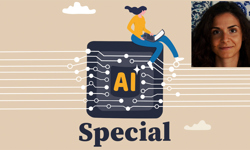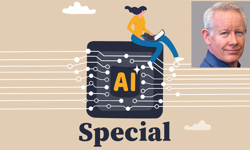
Q: How is Immediate Media using AI now?
A: Immediate’s AI strategy is split into four buckets of thinking and activity:
- Audiences & Ecosystem. What is the world looking like for our audiences and how are their needs and habits changing in a world influenced by GenAI?
- Learning & Transformation. What are the skills and ways of working needed within our company to best understand and benefit from the developments GenAI will kick start?
- Workflow Productivity. What are the everyday workflow use cases in which GenAI can genuinely add value and improve what we do, be it producing things faster, producing more of them, producing things better?
- Product Innovation. What are the technical progressions that mean we can serve our existing or new audiences with unique product innovations that will benefit daily life?
This last bucket recognises not only the benefits of improved innovations but also the necessity. Market innovations will change the ways we access and communicate with our customers and not all business model will thrive in the transition.
Our first step on the AI journey focused on education to power experimentation. We have taken the time to immerse all departments across the company, from the post room to the C-suite, in GenAI thinking, arming everybody with the awareness and skills needed to play and learn from an informed standpoint.
This experimentation is enabled through clear guardrails, technical support, and localised communities of practice where people can learn from each other in their relevant disciplines.
All experimentations are focused on adding value to audiences, empowering more human creativity and connection, not shortcutting tasks at the detriment of customer value.
Q: How do you expect your company to use AI in the future?
A: The tools and capabilities are changing all the time, so I expect it to remain iterative. High impact use cases will become productionised where they are proven to truly add value. This will be driven both for us, by the everyday tech solutions we use operationally and see become commonplace in third-party software, as well as by us, in the structures and processes introduced at the local team level, once we decide what works best. This will all happen in line with our editorial guardrails of best practice.
In short, it will all get more informed and consistent. We’ll move past the AI for AI’s sake era and settle on the use cases that make the most sense for our specific business aims. These will be the use cases that allow us to best serve diversified audience needs with expert, trusted content.
It will also reflect a changing customer marketplace where audiences are navigating a plethora of automated information sources and making decisions around what and how they consume media based, I believe, on trust, relevance, and relatability.
Three top tips
- Involve everyone. In all roles and all departments. AI will change the way we all work whether we like it or not. The degree to which these changes benefit the specific workflows in your business without losing nuanced value along the way depends on how informed those workflow use cases were in the first place. Whether they were informed by those who truly understand the jobs in hand and the needs of the customer or just use cases that made sense in theory. If GenAI use is viewed as a decision for the tech department only, or just the advocates naturally enthused by the GenAI hype, then those solutions will be reductive at best, detrimental and exclusionary at worst, and miss heaps of innovative opportunity along the way. Creating psychological safety and candid discussion is a vital first step to hear what people really think and separate the truculent naysaying from the legitimate insight and nuanced requirements.
- Stay iterative. Capabilities, tools, and use cases are changing and evolving all the time. As is the ecosystem in which publishers exist. Deciding on a 5-year strategy for GenAI use is pointless. Stay honest, collaborative, and curious and accept that the ways you are using GenAI will change radically over time but the learnings you are making along the way are vital regardless. The opportunity lies in the experimentation and the iterative nature of the learning. This is about the collective power of the hive mind, and the more diverse the hive, the better.
- Invest in creativity. AI will level the playing field for content creation making previously unimagined opportunities for production and ideation possible within a few keystrokes. If this is true for all creators, brands will survive and thrive based on the authenticity and creativity of the folks that work for them. Empower creative ingenuity within your teams through the spaces, expectations, and ways of working you establish for them. Create environments in which diversity of human connection and creativity can thrive. Our products, our audiences, and our marketplace are changing, and with them our business models too. Finding a creative advantage isn’t just beneficial, it will be vital for success.
Hannah and the other contributors to our AI Special took part in an ‘AI Special – Q&A’ webinar on Wednesday, 26 June. You can watch the recording by registering here.
This article was included in the AI Special, published by InPublishing in June 2024. Click here to see the other articles in this special feature.










